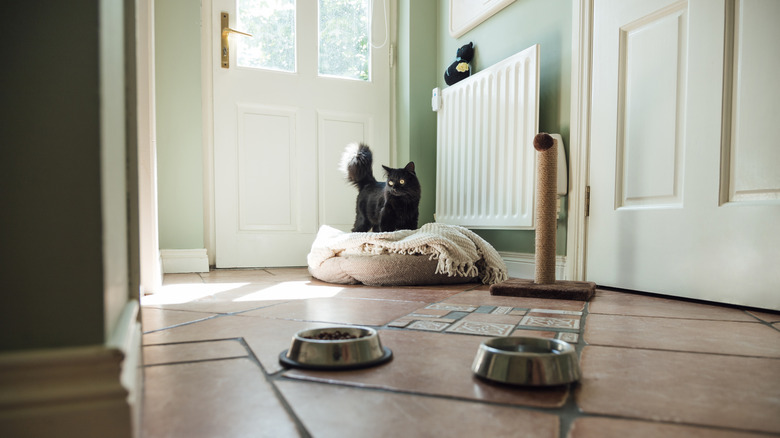The Action You Can Take To Make Your Cat Comfortable After A Move
Moving is an extremely big, stressful life event — and it's even more difficult if you have a cat. While you're packing up your life, labeling your belongings, cleaning your old place, and having movers come in to transfer boxes to your new home, your cat is probably confused, scared, and wondering just what is going on. Luckily, you can learn how to introduce a cat to a new home in a way that keeps them as comfortable as possible throughout the whole, unnerving process.
Weeks before you actually move, you want to get your cat comfy being around their carrier. Set it up in an area where your cat frequently hangs out and let them explore during the stress-free period. The next thing to consider is leaving your cat's belongings out as late as possible in the packing process. They're already going to sense that something is different as you pack your stuff, so don't disturb their routine until you absolutely have to.
Once you are in your new place, first of all, congratulations! Your cat will likely be more than a little freaked out. The most important thing you can do after you move is to make your cat as comfortable as possible. Set up one room as a safe haven to introduce them to for the first few days. If you let them loose in a brand new place, chances are very good that they will get confused and spooked and may hide in a place you haven't even found yet.
How to set up your cat's safe haven
There are several ways to minimize your cat's distress once you let them out into their brand-new environment. First, you want to kitty-proof the place — especially the room you're introducing them to. This means closing windows, tying up cords for your blinds, and tidying electrical cords and surge protectors. Whichever room you pick to keep them in for the first few days should contain their litter box, food, water, and favorite toys, including trees and scratching posts. As much as possible, it should be a room that has lots of familiar objects, meaning familiar furniture and décor. It's also a good idea to keep their carrier out and available to them in this safe haven. It will act as a familiar hiding spot they can retreat to if they're upset or afraid.
Finally, make sure you visit with your kitty often while they're getting used to their safe haven. Spend as much time there as you can cuddling, petting, and interacting as much as they allow. Use some techniques for comforting a scared cat, like having a consistent "starting gesture" and rewarding their calm behavior with treats. If it's possible, it's also a good idea for you to sleep in that room with them — bonus points if your kitty's safe haven is your new bedroom.
How to introduce your cat to the rest of your home
Once your cat seems to be fairly comfortable in their room, it's time to open up the door and let them explore the rest of their new home. However, before you do this, make sure to prep the space and make it as safe as possible for your kitty. Learn how to cat-proof your home and take the time to check every corner and hiding spot.
You know your feline friend best. If they attack your blinds, put them up. If they dig through the trash, get trash cans with lids. It's a new place for both of you, and once your kitty starts exploring, they're almost guaranteed to rifle through something they weren't supposed to or discover a new way to scratch a wall. It's all about minimizing their chances to do something destructive while keeping everyone safe and comfortable in the process.
For a few days, only let your cat out if you can supervise them. If you have too much to do or are leaving for a while, they can spend more time in their room. Once your kitty roams your whole new home without a problem, you are welcome to move the litter box and their food and water out to wherever makes the most sense. The most important thing is to follow your cat's lead. Some will be very quick to adapt and may only need a few days in their safe haven while others can take weeks or months to get comfortable in a new setting. Regardless, a little time and patience will help your kitty adjust.


